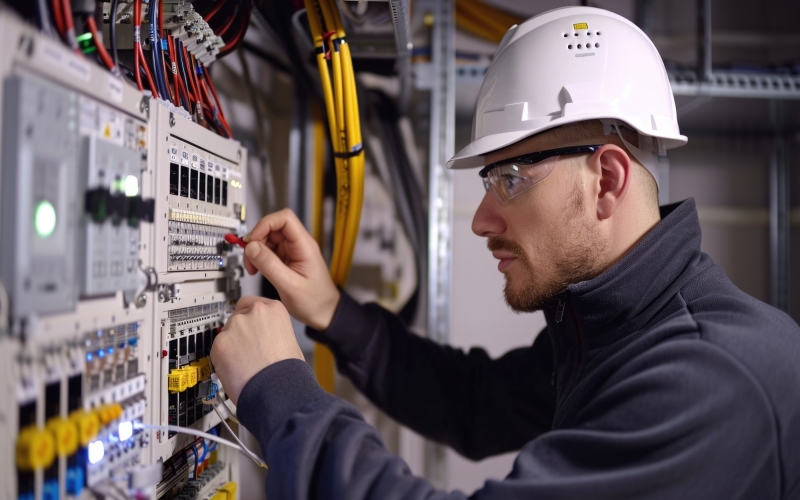Protecting a business goes beyond securing its physical premises or cyber defenses. At the heart of every modern enterprise lies an often-overlooked aspect: electrical safety. This is where smart circuit protection comes into play.
Smart circuit protection solutions are not just upgrades to existing systems. They’re innovative approaches redefining how businesses handle electrical safety. This article explores the transformative impact of these technologies in modern business environments.
Understanding Traditional Circuit Protection Systems
Traditional circuit protection involves circuit breakers and fuses. These components are designed to disrupt the flow of electricity in case of overload or short circuit, preventing damage and fires.
However, these systems have their limitations. They can’t always react swiftly to fluctuating electrical loads, nor can they provide insights into the electrical system’s health. Thus, there’s a pressing need for solutions that not only react to issues but also anticipate and prevent them.
The Concept Of Smart Circuit Protection Solutions
Smart circuit protection is an advanced system that goes beyond simple electrical interruption. It integrates software and hardware to monitor, control, and manage electrical circuits intelligently.
Unlike traditional systems, these smart solutions offer real-time data, predict potential issues, and provide remote control capabilities. The benefits are substantial: enhanced safety, reduced downtime, and a significant improvement in energy efficiency.
Key Features And Capabilities Of Smart Circuit Protection Solutions
In the field of electrical safety and efficiency, smart circuit protection solutions offer a range of innovative features. These capabilities enhance operational safety and streamline management processes.
-
Remote Monitoring And Control
The strategic advantage of remote monitoring and control lies in its capacity to allow businesses to oversee and manage their electrical systems from any location. This feature provides more than just convenience. It also enables informed decision-making based on comprehensive system data.
Its strategic value is in enhancing overall operational management, aiding in resource optimization, maintenance planning, and ensuring consistent business operations.
-
Real-Time Fault Detection And Response
The technical aspect of real-time fault detection and response is vital for immediate electrical safety. Utilizing advanced sensors and analytics, these systems continuously monitor for electrical issues and react swiftly to any detected anomalies.
This rapid response is crucial to minimizing potential damage and preventing operational disruptions, offering a proactive and responsive layer of protection.
-
Predictive Maintenance And Troubleshooting
Predictive maintenance uses data analysis to anticipate and prevent electrical problems before they occur. This approach extends beyond immediate issue resolution, improving the longevity and reliability of electrical systems.
By optimizing maintenance schedules and reducing unexpected downtime, it contributes significantly to operational efficiency and cost-effectiveness. Efficient troubleshooting also ensures quick identification and resolution of issues, which enhances system dependability.
-
Energy Management And Optimization
By monitoring energy usage patterns and identifying areas of inefficiency, these systems enable businesses to optimize their energy consumption. This leads to cost savings and supports environmental sustainability goals.
Moreover, adjusting energy usage dynamically based on collected data helps achieve optimal operational efficiency, making these solutions a smart choice for energy-conscious businesses.
These features collectively contribute to a safer, more efficient, and sustainable operational environment for businesses.
Implementation And Integration Of Smart Circuit Protection Solutions
Implementing and integrating smart circuit protection solutions into a business’s existing electrical infrastructure is a strategic move towards enhanced safety and efficiency. This intricate process is crucial for maximizing the benefits of these advanced systems. Here’s an overview of the steps involved:
- Assessment And Planning: The process begins with a detailed assessment of the current electrical setup, identifying areas for improvement and defining specific business needs. This stage involves selecting the right smart circuit protection system that aligns with the business’s operational scale, compatibility requirements, and future growth plans.
- Installation And Configuration: Installation requires skilled professionals who ensure that all components are correctly installed and configured. This step is critical for achieving optimal system performance and includes hardware setup, software integration, and thorough testing.
- Integration With Existing Infrastructure: Integrating the new system with existing electrical infrastructure is indispensable in maintaining operational continuity. This integration often requires minimal modifications, making smart circuit protection solutions adaptable to various setups.
- Training For Effective Utilization: Equipping staff with the knowledge to effectively use and maintain the new system is essential. Training sessions should cover system operation, monitoring techniques, and response protocols to maximize the system’s capabilities and ensure its long-term effectiveness.
- Maintenance And Support: Regular maintenance and access to reliable support are vital for the sustained performance of smart circuit protection systems. This includes routine checks, software updates, and prompt troubleshooting to keep the system running smoothly.
- Integration With Other Smart Building Technologies: For an enhanced operational ecosystem, these solutions can be integrated with other smart technologies like Internet of Things (IoT) devices and energy management systems. This creates a more comprehensive and efficient management platform.
- Adherence To Compliance And Safety Standards: Ensuring that the system meets relevant safety and industry standards is imperative for legal compliance and operational reliability. Regular audits and inspections help maintain these standards.
Although the integration process requires careful execution, the long-term advantages in terms of safety, operational efficiency, and energy management make it a valuable investment for any modern enterprise.
Final Thoughts
Smart circuit protection solutions provide significant advantages for contemporary businesses, strengthening electrical safety and operational reliability. Integrating these systems into existing infrastructure represents a sound investment, ensuring a balance between protection and efficiency.
This technology equips enterprises with essential tools for a secure and efficient future, highlighting its value in the modern business environment.

